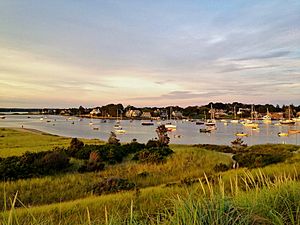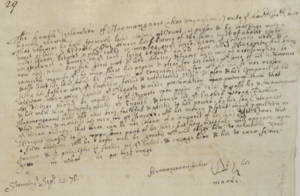Harman Garrett facts for kids
Harman Garrett (born around 1610, died around 1678) was an important Native American leader. He was a Niantic sachem, which means a chief or leader. Later, he became a governor for the Eastern Pequot people. His lands were located near the Pawcatuck River in what is now Westerly, Rhode Island. He was also known by other names like Cashawashett or Wequashcook II. He chose the English name Harman Garrett by 1654.
Contents
Who Was Harman Garrett?
Harman Garrett was the son of a Niantic sachem named Wepitanock. His grandfather was also a sachem named Saccious. Harman Garrett was the half-brother of Wequash Cooke. Wequash Cooke helped the colonial military during the Pequot War in 1637. After Wequash Cooke passed away in 1642, Harman Garrett tried to take on his brother's leadership role. However, his uncle, Ninigret, disagreed. This was because Garrett's mother was not fully Niantic.
Harman Garrett and the Pequot Lands
In the 1640s, Harman Garrett worked with John Mason from the Saybrook Colony. They talked about Garrett's land boundaries with the United Colonies. Garrett wanted to lead some of the Pequot people who had been defeated in the war. He also wanted to claim some of their former lands.
Despite some disagreements from other Native American leaders, Garrett started hunting in Pequot territory in 1646. By 1648, with Mason's help, Garrett started a small community. This community included Niantics and former Pequots. It was located on the west side of the Pawcatuck River. This group was somewhat allied with Uncas against Ninigret. John Winthrop, Jr. later became Garrett's supporter. Winthrop helped Garrett with his settlement at Pawcatuck. Garrett's own home was in Pawcatuck.
Becoming Governor of the Eastern Pequots
In 1654, Captain Simon Willard led a mission from Massachusetts. They made Ninigret give control of the Pequots under his rule to the United Colonies. By May 1654, Garrett had taken the name of a gunsmith from Massachusetts, Herman Garrett. Native Americans sometimes adopted names related to firearms. This was a way to show their bravery in battle.
In September 1655, the leaders of the United Colonies chose Harman Garrett as governor. He was put in charge of these Pequots and Niantics. His job was to collect payments owed by the Pequots since the Pequot War. He also helped settle disagreements. Thomas Stanton worked with him.
In 1661, leaders from Massachusetts helped Garrett and his uncle Ninigret settle a land dispute. This was about land in and around Westerly. By 1663, new settlers were moving onto the land. This caused more land problems. Because of this, Garrett moved to Southertowne, which is now Stonington.
Later Life and Legacy
In 1676, during King Philip's War, Harman Garrett fought alongside colonial forces. He, along with Oneco and Cassasinamon, helped capture and execute the Narragansett Sachem Canonchet.
After Harman Garrett's death, his group of Native Americans received land in northern Stonington in 1683. Garrett had planned to leave his property to his son, Cattepeset. However, Garrett's deputy, Mamaho, took power after Garrett passed away. This led to a power struggle with Cassacinamon's group.



